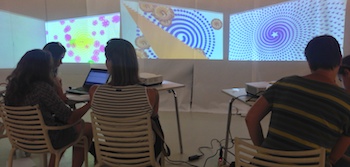Programming in a museum? Creative coding for art mediation
With Jonathan Perret, we designed a workshop inspired by computer art for 9-13 year-old at Pompidou Center: “Code, colors and cookies”. You can find all the codes and some of the kids creations on the Github for the workshop.

Kids use Processing to create pictures projected on the walls by 12 video projectors–yes, it’s 1 video projector per child!
During the 2 hours of the workshop the kids and their family also go up in the museum, following museum professionals (“animatrices”) to see 3 paintings from Kupka, Valensi and McDonald Wright dating from 1920 to 1955. They discover how computer code make us see them in a different light.
Thanks to the paintings, the young programmers and their parents also came back with fresh ideas: “We tried to imagine how to program the shapes that we saw in the paintings”.

In designing the workshop, we kept the structure that the museum use for its workshops, based on a mix of phases of active creation and a visit in the museum.
Our goal with this workshop is to introduce computer code as an universal material for mediating art. Just like paper or modeling clay can be used to actively relate to the work of great artists, code can be used as a base material to explore various kind of art, not just digital art.
The Pompidou Center has a long history with generative art, as evidenced by the small anthology I collected at the bottom of this text. Then, it was not necessary to use this particular creative process too literally. We especially didn’t want to use computer art to relate exclusively to digital art, as it would put creative programming in a too narrow frame.

That is why the selected works are paintings of Kupka, Valensi and McDonald Wright, painted between 1920 and 1955. You can use photography to relate to sculptures, you can use cardboard to relate to furniture design… and you can use code to build a relationship with paintings from the 30’s!
A dedicated format, for a specific museum
Instead of forcing a learn-to-code format designed for another context – a programming workshop, a robotics class, a parent-organized Coding Goûter– we created a native format rooted in the practices of Pompidou Center.
We started from the context of the National Museum of Modern Art, its collections, its current permanent exhibition presentation, its technical resources and the experience of its educational team in creating children’s workshop.
The format was developed through numerous discussions. We had the occasion to experience with our children the Museum workshops, and it helped us understand the dynamics, the formats and the motivations of the facilitators. Selecting the artworks was an opportunity to reflect on the dialogue between kinetic abstract paintings and contemporary generative art. We worked with Jonathan a full day in the very space of the workshops - which led us to decide on covering the walls with video projections, all around the room.

The integration of two facilitators from the Center at the workshop will allow a gradual appropriation of computer code as an additional material for the children workshops at Pompidou Centre, alongside paper, objects, photography…
A long history between the Center and generative art
Preparing this workshop I had the opportunity to list some examples of the long history between the Centre Pompidou and generative art.
As a teenager, I had the opportunity to experience the monumental installation Genetic Images by Karl Sims installed at Pompidou Center in 1993 http://www.karlsims.com/genetic-images.html
This photo is probably of the installation at Pompidou Center itself: http://www.karlsims.com/genetic-images.jpg in the space that is now just after the staff entrance. Genetic Images has only been installed 3 times. Its installation at the center as part of the Revue Virtuelle is especially significant.
Genetic Images on the Pompidou Center website: http://www.cnac-gp.fr/cpv/ressource.action?param.id=FR_R-42b8c1e2d526d6ac561246cd26349f5¶m.idSource=FR_E-42b8c1e2d526d6ac561246cd26349f5 Le National Museum of Modern Art (part of the Pompidou Center) also has in its collections videos from Karl Sims, halfway between demos of advanced simulation algorithms and generative art. You can watch them in the video kiosks space in the museum.
Anecdotally, the museum has a work of Casey Reas, the original creator of Processing with Ben Fry. Processing is the most popular “programming language for artists” and we use it for our workshop. http://www.centrepompidou.fr/cpv/ressource.action?param.id=FR_R-266d2bce1d4b9622c7be85e00278¶m.idSource=FR_O-5d3c8e648686ddbc7c1e406c7456677f
Manfred Mohr is a co-founder of the “Art and Computer” seminar in… 1968 at the Vincennes University (Now called Paris 8) http://www.emohr.com
The Centre has a relatively recent work of his: http://www.centrepompidou.fr/cpv/ressource.action?param.id=FR_R-4b51c458b2e74e743914f264a1de112¶m.idSource=FR_O-d3a3d092158097d96b8a9e1a68924fa3
Vera Molnár began as early as 1968 to create works on paper calculated by computer. Initially two computers were necessary, one to make calculations, and a second in another institution to draw the results on a tracer. Personal computers did not exist in 1968, the calculations were made on scientific computers. Graphic displays did not exist either, plotting on paper was thus the required rendering mode. http://www.veramolnar.com/
His work in the 60s and 70s : http://dam.org/artists/phase-one/vera-molnar/artworks-bodies-of-work/works-from-the-1960s-70s
160 square pushed to the limit is a set of computer drawings form 1976. Eight drawings in this series are held in the collection of the graphical art studio of the Centre Pompidou: http://www.centrepompidou.fr/cpv/ressource.action?param.id=FR_R-c2f09c215b8ad68194d474c01d8cd1¶m.idSource=FR_O-1a1e5a215fb6166a1c4abf90707c1a7c and here: http://www.centrepompidou.fr/cpv/ressource.action?param.id=FR_R-2db6ac47ca795f81910e691d8596c7¶m.idSource=FR_O-15ba268828b455b80a08b30d7f0b2c
